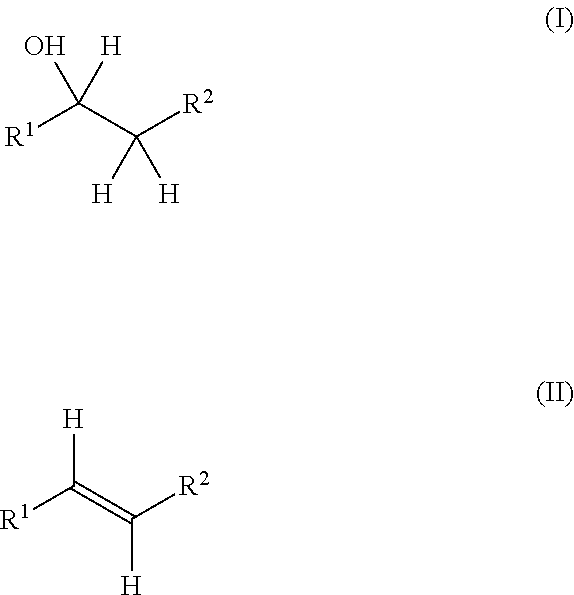Production method for olefin, and dehydration catalyst employed in same
a production method and catalyst technology, applied in the direction of hydrocarbon preparation catalysts, physical/chemical process catalysts, bulk chemical production, etc., can solve the problems of sharp decline in selectivity, economic efficiency can be deteriorated, reaction activity and propylene selectivity deteriorate sharply, etc., to achieve high alcohol conversion, high selectivity, and high efficiency
- Summary
- Abstract
- Description
- Claims
- Application Information
AI Technical Summary
Benefits of technology
Problems solved by technology
Method used
Image
Examples
example 1
[0072]A 50 ml beaker was charged with 10.0 g of silica gel CARiACT (Q-10) manufactured by Fuji Silysia Chemical Ltd. and 25 g of a 1.39% by weight aqueous aluminum nitrate solution. These were left to stand at room temperature for one hour; and excess aqueous aluminum nitrate solution (about 15 g) with which the silica gel was not impregnated was removed by a filtration procedure. The residue was dried at 120° C. for three hours and calcined at 500° C. for six hours to give a silica gel (X) in which aluminum was supported in the amount of 1,000 ppm by weight as a dehydration catalyst according to the present invention. The catalytic performance in dehydration of the present catalyst was evaluated in accordance with the dehydration catalyst evaluation method. The results are described in Table 1.
example 2
[0073]The same procedures as described in Example 1 were carried out except that Q-15 was used in place of the silica gel Q-10 and a 2.78% by weight aqueous aluminum nitrate solution was used in place of the 1.39% by weight aqueous aluminum nitrate solution, thereby giving a silica gel (X) in which aluminum was supported in the amount of 2,000 ppm by weight. The catalytic performance in dehydration of the present catalyst was evaluated in accordance with the dehydration catalyst evaluation method. The results are described in Table 1.
example 3
[0074]The same procedures as described in Example 2 were carried out except that Q-20 was used in place of the silica gel Q-15 in Example 2, thereby giving a silica gel (X) in which aluminum was supported in the amount of 2,000 ppm by weight. The catalytic performance in dehydration of the present catalyst was evaluated in accordance with the dehydration catalyst evaluation method. The results are described in Table 1.
PUM
| Property | Measurement | Unit |
|---|---|---|
| pore diameter | aaaaa | aaaaa |
| pore diameter | aaaaa | aaaaa |
| temperature | aaaaa | aaaaa |
Abstract
Description
Claims
Application Information
 Login to View More
Login to View More - R&D
- Intellectual Property
- Life Sciences
- Materials
- Tech Scout
- Unparalleled Data Quality
- Higher Quality Content
- 60% Fewer Hallucinations
Browse by: Latest US Patents, China's latest patents, Technical Efficacy Thesaurus, Application Domain, Technology Topic, Popular Technical Reports.
© 2025 PatSnap. All rights reserved.Legal|Privacy policy|Modern Slavery Act Transparency Statement|Sitemap|About US| Contact US: help@patsnap.com



